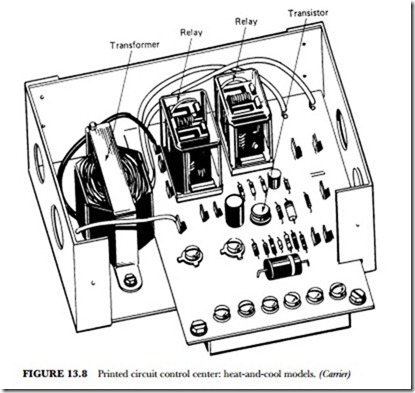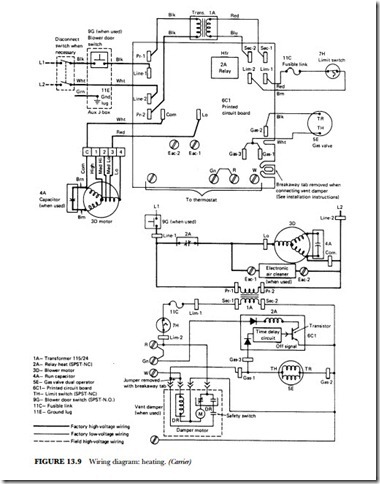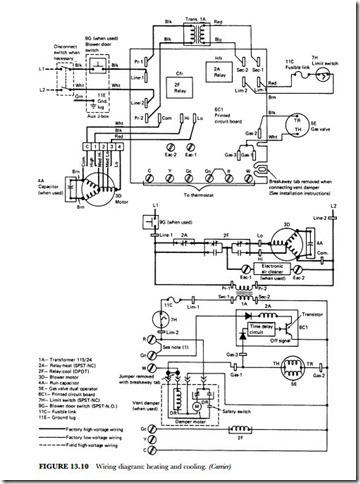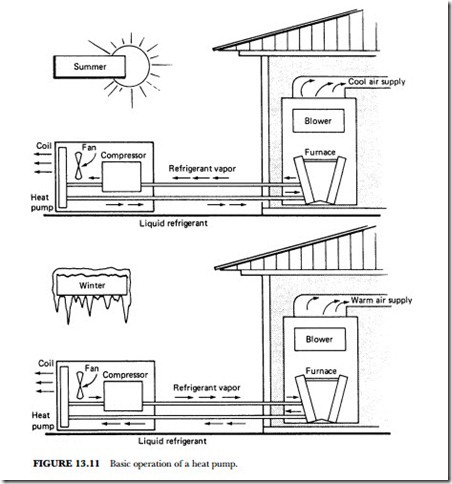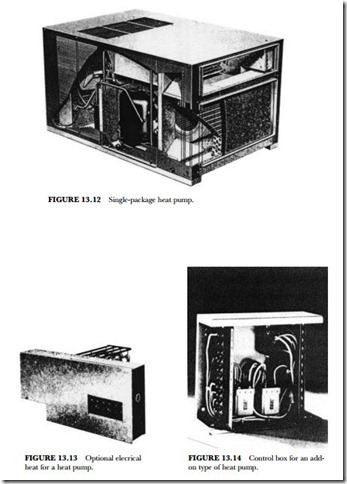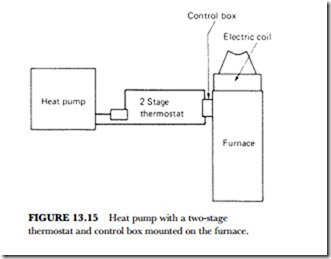HEAT PUMPS
The heat pump is a heat multiplier. It takes warm air and makes it hot air. This is done by compressing the air and increasing its temperature. Heat pumps have received more attention since the fuel embargo of 1974. Energy conservation has become a more important concern for everyone. If a device can be made to take heat from the air and heat a home or commercial building, it is very useful to many people.
The heat pump can take the heat generated by a refrigeration unit and use it to heat a house or room. Most take the heat from outside the home and move it indoors (see Figure 13.11). This unit can be used to air-condition the house in the summer and heat it in the winter by taking the heat from the outside air and moving it inside.
On mild-temperature heating days, the heat pump handles all heating needs. When the outdoor temperature reaches the balance point of the home—that is, when the heat loss is equal to the heat-pump heating capacity—the two-stage indoor thermostat activates the furnace (a secondary heat source, in most cases electric heating elements). As soon as the furnace is turned on, a heat relay de-energizes the heat pump.
When the second-stage (furnace) need is satisfied and the plenum temperature has cooled to below 90 and 100 degrees F, the heat-pump relay turns the heat pump back on and controls the conditioned space until the second-stage operation is required again. Figure 13.12 shows the heat-pump unit. The optional electric- heat unit shown in Figure 13.13 is added in geographic locations where needed. This particular unit can provide 23,000 to 56,000 Btus per hour (Btuh) and up to 112,700 Btuh with the addition of electric heat.
If the outdoor temperature drops below the setting of the low-temperature compressor monitor, the control shuts off the heat pump completely, and the furnace handles all the heating needs.
During the defrost cycle, the heat pump switches from heating to cooling. To prevent cool air from being circulated in the house when heating is needed, the control automatically turns on the furnace to compensate for the heat-pump defrost cycle (see Figure 13.14). When supply air temperature climbs above 110 to 120 degrees F, the defrost-limit control turns off the furnace and keeps indoor air from getting too warm.
If, after a defrost cycle, the air downstream of the coil rises above 115 degrees F, the closing point of the heat-pump relay, the compressor will stop until the heat exchanger has cooled down to 90 to 100 degrees F, as it does during normal cycling operation between furnace and heat pump.
During summer cooling, the heat pump works as a normal split system, using the furnace blower as the primary air mover (see Figure 13.15).
In a straight heat-pump/supplementary-electric-heater application, at least one outdoor thermostat is re- quired to cycle the heaters as the outdoor temperature drops. In the system shown here, the indoor thermo- stat controls the supplemental heat source (furnace). The outdoor thermostat is not required.
Since the furnace is serving as the secondary heat source, the system does not require the home rewiring usually associated with supplemental electric strip heating.
Special Requirements of Heat-Pump Systems
The installation, maintenance, and operating efficiency of the heat-pump system are like those of no other comfort system. A heat-pump system requires the same air quantity for heating and cooling. Because of this, the air-moving capability of an existing furnace is extremely important. It should be carefully checked be- fore a heat pump is added. Heating and load calculations must be accurate. System design and installation must be precise and according to the manufacturer’s suggestions.
The air-distribution system and diffuser location are equally important. Supply ducts must be properly sized and insulated. Adequate return air is also required. Heating-supply air is cooler than with other systems. This is quite noticeable to homeowners accustomed to gas or oil heat. This makes diffuser location and system balancing critical.
Heat-Pump Combinations
There are four ways to describe the heat-pump methods of transporting heat into the house:
• Air-to-air: the most common method and the type of system previously described
• Air-to-water: this method uses two different types of heat exchangers: warmed refrigerant flows through pipes to a heat exchanger in the boiler, and heated water flows into radiators located within the heated space
• Water-to-water: this type uses two water-to-refrigerant heat exchangers; heat is taken from the water source (well water, lakes, or the sea) and passed on by the refrigerant to the water used for heating; the reverse takes place in the cooling system
• Water-to-air: well water furnishes the heat by warming the refrigerant in the heat-exchanger coil; the refrigerant, compressed, flows to the top of the unit, where a fan blows air past the heat exchanger
Each type of heat pump has its advantages and disadvantages. The electrical connections and controls are used to do the job properly. Before attempting to work on this type of equipment, make sure you have a complete schematic of the electrical wiring and know all the component parts of the system.
Related posts:
Incoming search terms:
- different heat pump circuits
- different types of heat pump circuits
- heat pump circuits
- different circuit of heat pump
- what are the heat pump circuits
- heat pump circuit
- heat pump cicuits
- Expailn in detail about Heat pump Circuits
- difgerent heat pump circuits
- diffrent heat pump circuits
- different heatpump circuits
- what is heat pump circuits
